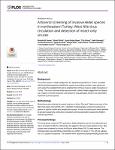Arboviral screening of invasive Aedes species in northeastern Turkey: West Nile virus circulation and detection of insect-only viruses
Akıner, Mustafa M.
Öztürk, Murat
Buğra Başer, Aykut
Günay, Filiz
Hacıoğlu, Sabri
Brinkmann, Annika
Emanet, Nergis
Alten, Bülent
Özkul, Aykut
Nitsche, Andreas
Linton, Yvonne-Marie
Ergünay, Koray
Background
The recent reports of Aedes aegypti and Ae. albopictus populations in Turkey, in parallel with the territorial expansion identified in several surrounding countries, have raised concerns about the establishment and re-establishment of these invasive Aedes mosquitoes in Turkey. This cross-sectional study was performed to detect Aedes aegypti and Ae. albopictus in regions of recent incursions, and screen for viral pathogens known to be transmitted elsewhere by these species.
Methodology
Mosquitoes were collected at several locations in Artvin, Rize and Trabzon provinces of the Black Sea region during 2016–2017, identified morphologically, pooled and analyzed via generic or specific nucleic acid amplification assays. Viruses in positive pools were identified by product sequencing, cell culture inoculation and next generation sequencing (NGS) in selected specimens.
Principal findings
The study group comprised 791 specimens. Aedes albopictus was the most abundant species in all locations (89.6%), followed by Ae. aegypti (7.8%) and Culex pipiens (2.5%). Mosquitoes were screened for viruses in 65 pools where fifteen (23.1%) were reactive. The infecting strains was identified as West Nile virus (WNV) in 5 pools (7.7%) with Ae. albopictus or Cx. pipiens mosquitoes. The obtained WNV sequences phylogenetically grouped with local and global lineage 1 clade 1a viruses. In 4 (6.2%) and 6 (9.2%) pools, respectively, cell fusing agent virus (CFAV) and Aedes flavivirus (AEFV) sequences were characterized. NGS provided a near-complete AEFV genome in a pool of Ae. albopictus. The strain is provisionally called “AEFV-Turkey”, and functional analysis of the genome revealed several conserved motifs and regions associated with virus replication. Merida-like virus Turkey (MERDLVT), a recently-described novel rhabdovirus, was also co-detected in a Cx. pipiens pool also positive for WNV.
Conclusions/Significance
Invasive Aedes mosquitoes are established in certain locations of northeastern Turkey. Herein we conclusively show the role of these species in WNV circulation in the region. Biosurveillance is imperative to monitor the spread of these species further into Asia Minor and to detect possible introduction of pathogens.
Author summary
Mosquitoes can transmit viruses to susceptible humans during blood-feeding. The presence and establishment of particular mosquito species within a region is the prerequisite for the introduction and emergence of the diseases transmitted by that species. Aedes mosquitoes transmit dengue and yellow fever, as well as recently-emergent chikungunya and Zika viruses to susceptible humans. Mosquitoes were collected in the Black Sea region of Anatolia, NE Turkey, where invasive Aedes mosquitoes have recently encroached, and specimens were screened for a variety of viruses. We observed particular Aedes species that are associated with disease transmission, suggesting that these species have been established in the region. We did not detect dengue, yellow fever, chikungunya or Zika viruses, but West Nile virus was found in several pools of these invasive species. Moreover, we detected a number of related viruses that exclusively infect mosquitoes, identified for the first time in Anatolia. Using advanced sequencing technologies, the near-complete genome of a new Aedes flavivirus (AEFV-Turkey) was achieved.

